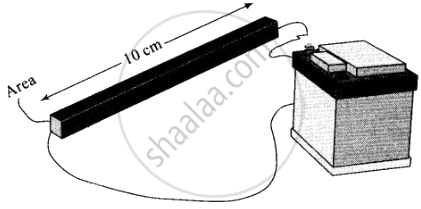Advertisements
Advertisements
Question
A metal rod of length 10 cm and a rectangular cross-section of 1 cm × `1/2` cm is connected to a battery across opposite faces. The resistance will be ______.
Options
maximum when the battery is connected across 1 cm × `1/2` cm faces.
maximum when the battery is connected across 10 cm × `1/2` cm faces.
maximum when the battery is connected across 10 cm × `1/2` cm faces.
same irrespective of the three faces.
Solution
A metal rod of length 10 cm and a rectangular cross-section of 1 cm × `1/2` cm is connected to a battery across opposite faces. The resistance will be maximum when the battery is connected across 1 cm × `1/2` cm faces.
Explanation:
The resistance of a wire depends on various parameters, its area, material (resistivity) and length (length of the rod).
Here, the metallic rod behaves as a wire.
The relationship between resistance and various parameter is given by R = ρl/A.

The resistance of a wire is given by R = `p l/A`
For greater value of R, l must be higher and A should be lower and it is possible only when the battery is connected across 1 cm × `(1/2)` cm (area of corss-section A).
APPEARS IN
RELATED QUESTIONS
Let the resistance of an electrical component remains constant while the potential difference across the two ends of the component decreases to half of its former value. What change will occur in the current through it?
What is Resistivity?
Keeping the p.d. constant, the resistance of a circuit is halved. The current will become:
(a) one-fourth
(b) four time
(c) half
(d) double
Fill in the following blank with suitable words:
Resistance is measured in .............. The resistance of a wire increases as the length ..............; as the temperature ..............; and as the cross-sectional area .............. .
The resistors R1, R2, R3 and R4 in the figure given below are all equal in value.

What would you expect the voltmeter A, B and C to read assuming that the connecting wires in the circuit have negligible resistance?
What is the necessary condition for a conductor to obey Ohm’s law?
A car bulb connected to a 12 volt battery draws 2 A current when glowing. What is the resistance of the filament of the bulb? Will the resistance be more same or less when the bulb is not glowing?
In the circuit shown below in Fig, calculate the value of x if the equivalent resistance between A and B is 4 Ω.

State the limitations of Ohm’s law.
Explain the equivalent resistance of a parallel resistor network.
